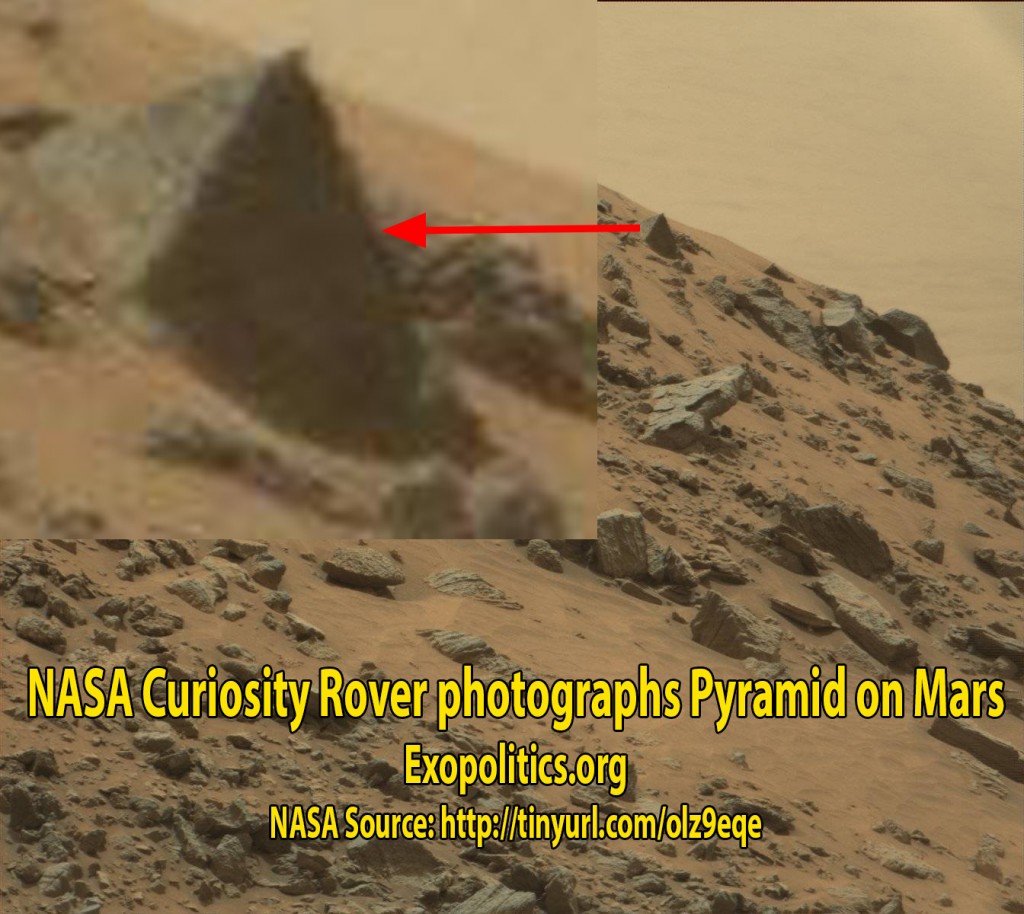
NASA Curiosity Rover photographs pyramid on Mars

On May 7, NASA’s Curiosity Rover photographed what clearly appears to be a pyramid on Mars. The pyramid is estimated to be the size of a small car or the capstone of a much larger pyramid buried beneath the Martian sand. The straight-line geometry and symmetry of the pyramid points to it being artificially created rather than a mere geological formation. The pyramid is among the clearest photographic evidence collected so far that artificial structures exist on Mars built by an earlier civilization.
The image was taken by the Curiosity Rover’s Right Mastcam on Sol 978 (May 7). Despite the startling symmetry of the pyramid, none of the Curiosity Rover’s subsequent photos taken at 20 to 30 sec intervals in the following few minutes and the subsequent photos hours later, included the object. It appears that the NASA operators of Curiosity deliberately chose not to take another photo or zoom in on the pyramid. If they however did so, none of these subsequent photos were released to the general public.
A Youtube video of the pyramid compares it to human-made pyramids that are similar in size to what was photographed by the Curiosity Rover. There is good reason to suspect, however, that the actual size of the Mars pyramid is much larger given the amount of debris and sand around it.
The Curiosity Rover image follows upon other photographs of the Mars surface that clearly show artificially created objects. A Mars Global Surveyor image from March-August 2000 showed what appears to be a base or flying saucer shaped object perched on the edge of a cliff. The image can be found on the Malin Space Science Systems website which designed the camera used by NASA’s Mars Global Surveyor Orbiter.
The Mars Global Surveyor object is symmetrical with what appear to be observation windows. The structure does not appear to be damaged at all, and shows no telltale signs of atmospheric wear and tear. The object has a smooth contour with polished edges. This suggests the structure is currently in use. Its position overlooking a canyon raises the strong possibility that it is an observation post belonging to or attached to a nearby base.
It’s not just artificial structures that have been photographed on Mars by NASA rovers or orbiters. According to a whistleblower called “Jackie”, whose job in 1979 was to monitor NASA’s telemetry equipment with the Viking Mission, she and her colleagues saw on video monitors two men in environmental suits casually walk up to one of the two Viking Landers on Mars. Jackie and her colleagues couldn’t believe their eyes and quickly ran upstairs to the main NASA telemetry room to check if the main video feeds showed the same thing. They were locked out! NASA was covering up video evidence of men walking around on Mars from its own employees!
What Jackie and her NASA colleagues saw that day was video evidence of a highly classified space program with astronauts, and one or more nearby bases on Mars. This suggests that what the Mars Global Surveyor Orbiter photographed in 2000 may well have been an observation post belonging to a secret Martian base.
All this helps to confirm that life presently exists on Mars, and did so in the ancient past. Artificial structures such as pyramids were likely built all over Mars; and, like those found on Earth, could have been very large. The Curiosity Rover may have only photographed the tip of a pyramid most of which is buried beneath the Mars surface. What we know from the 2000 Global Survey photo, Jackie’s testimony and Curiosity Rover images, is that NASA photographs are only the proverbial tip of the pyramid when it comes to evidence of artificial structures and past civilizations on Mars.
© Michael E. Salla, Ph.D. Copyright Notice
FURTHER READING
Curiosity Rover, extraterrestrial life, Mars, Mars Global Surveyor, pyramids, secret space programs